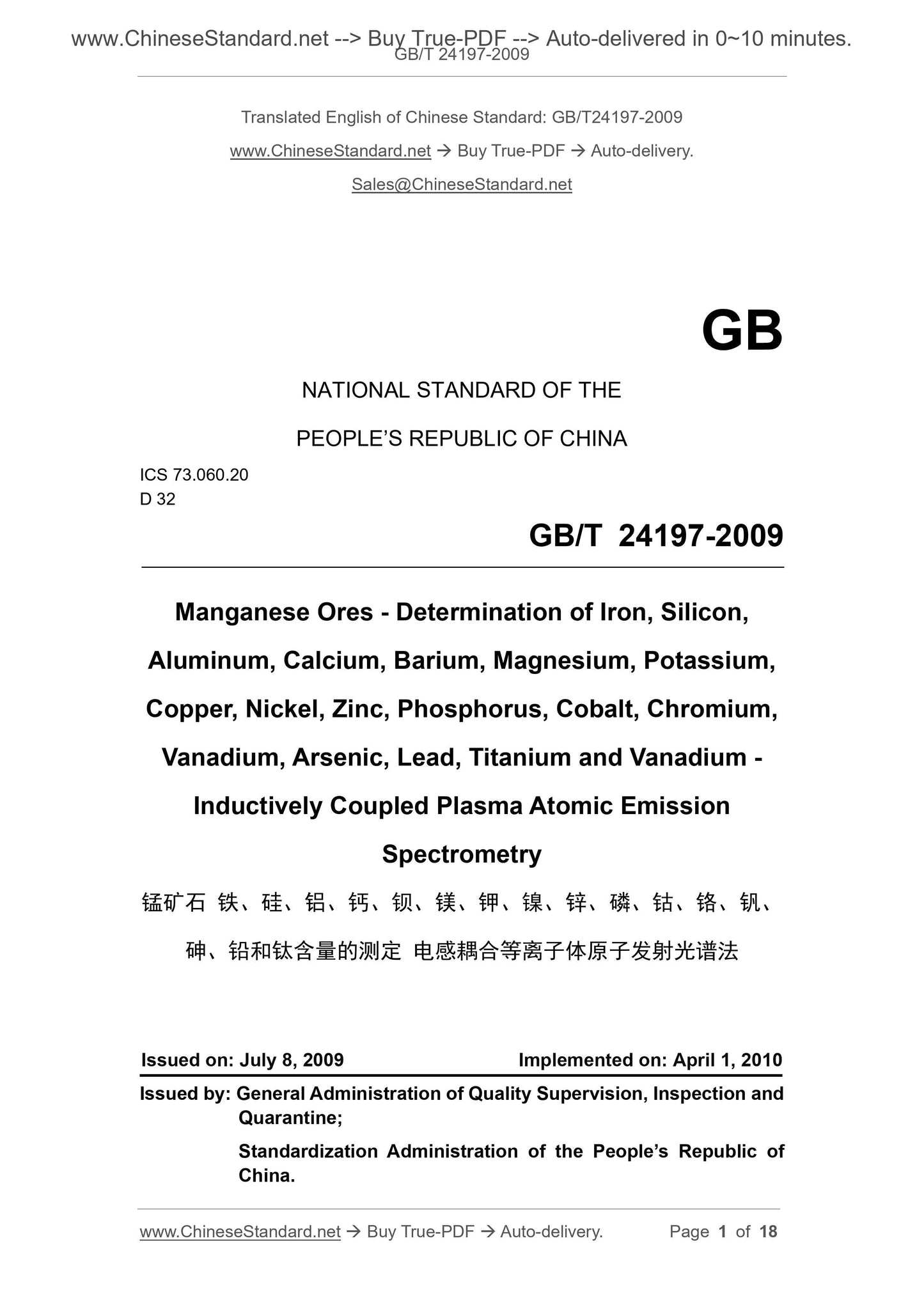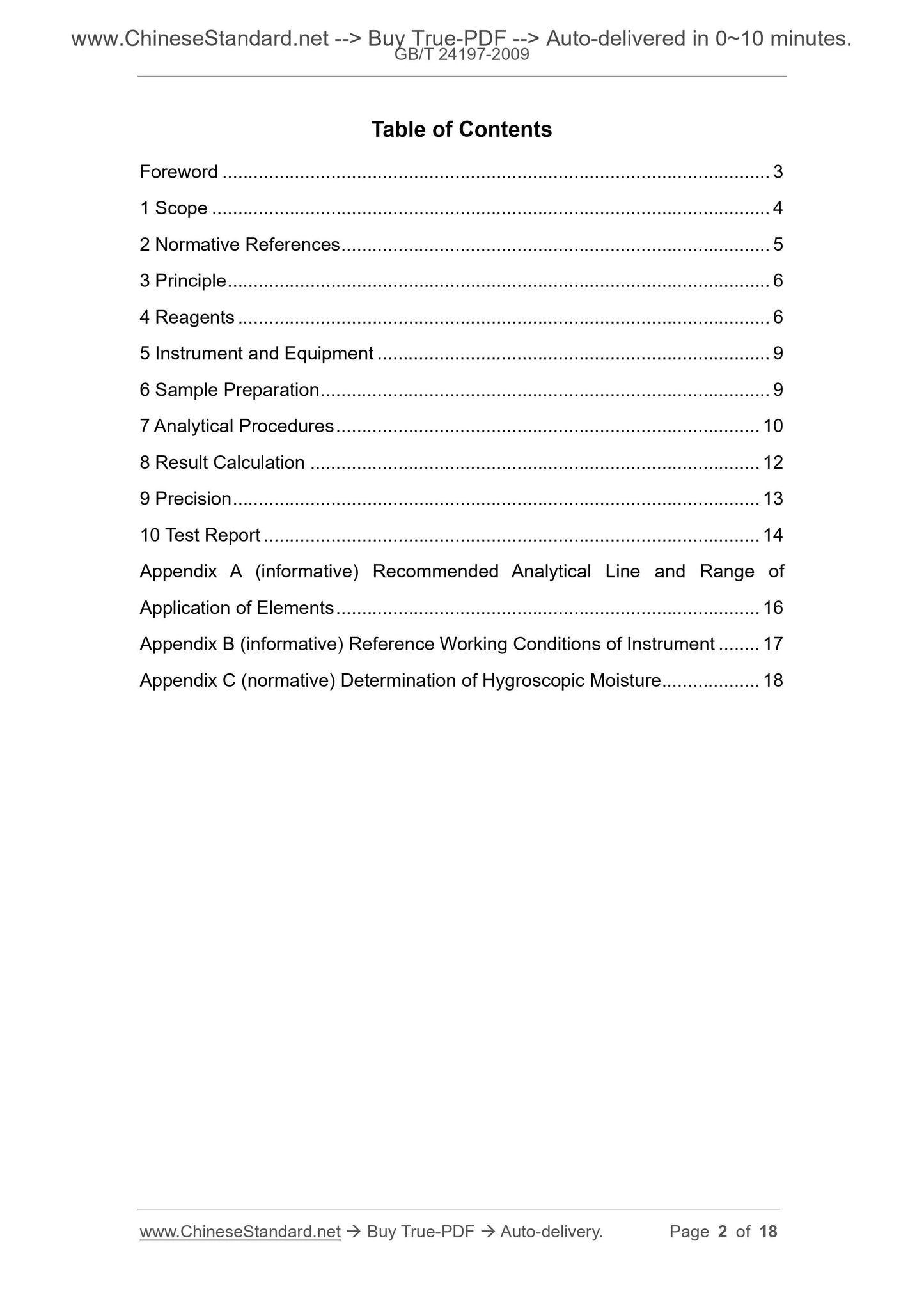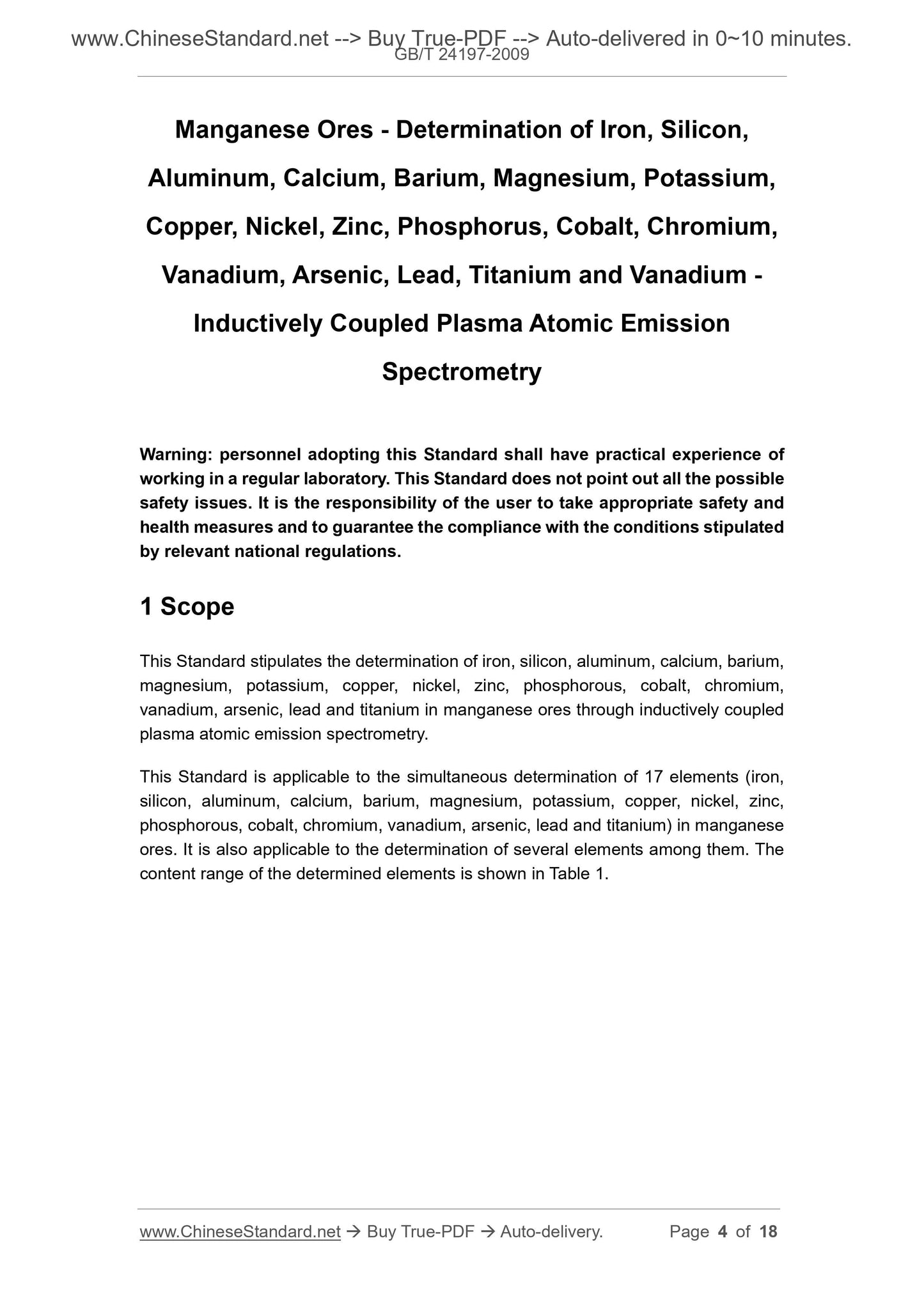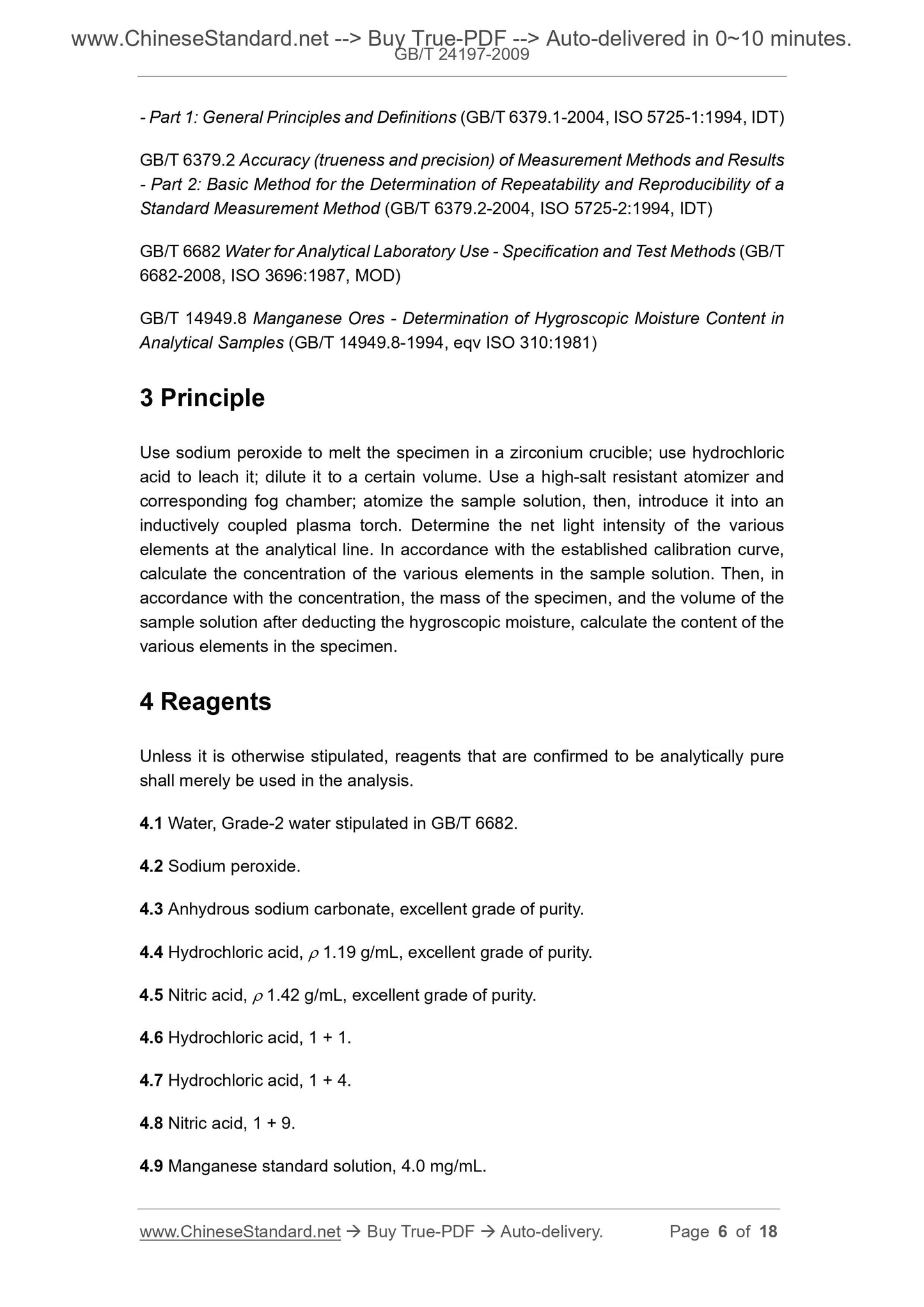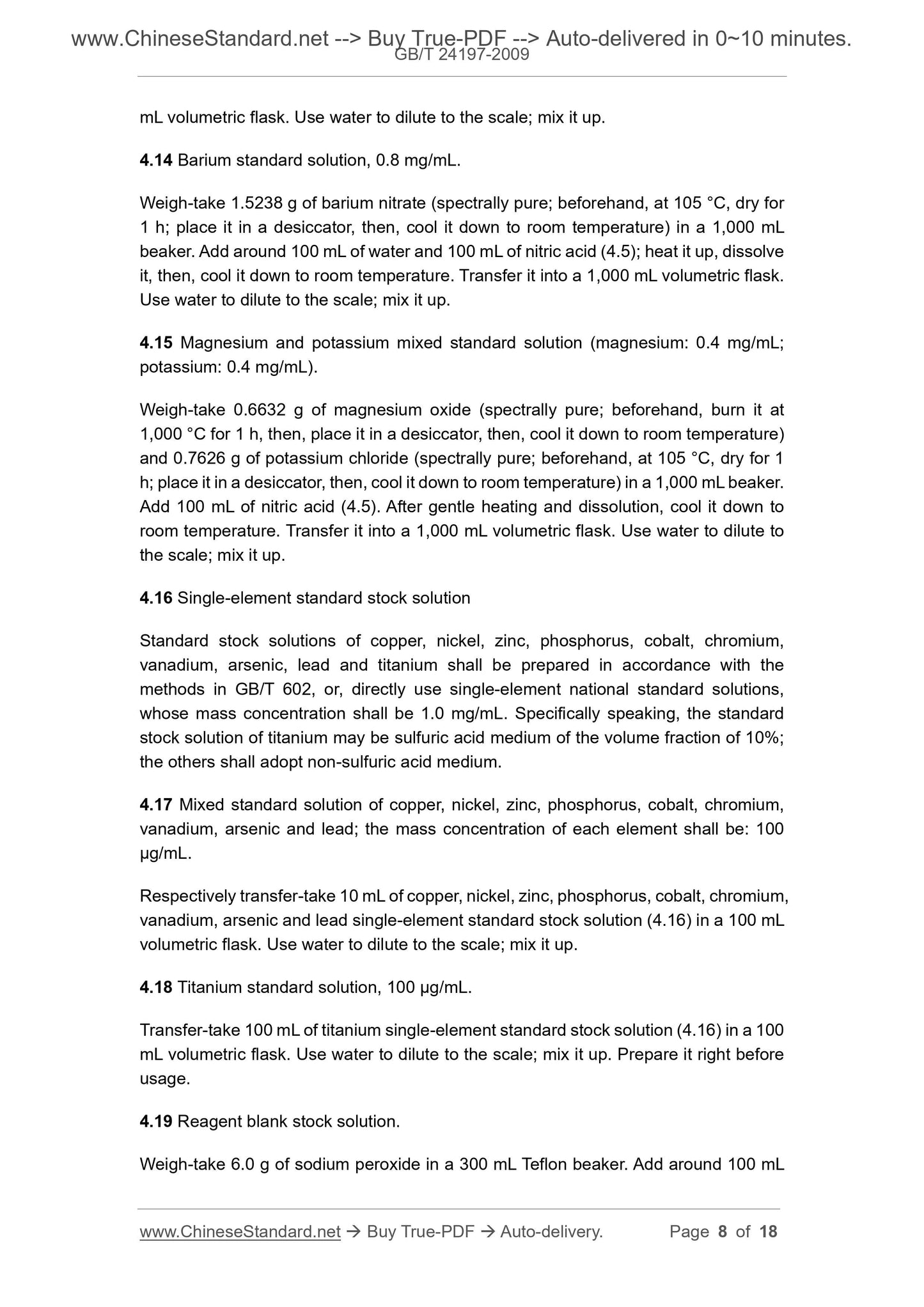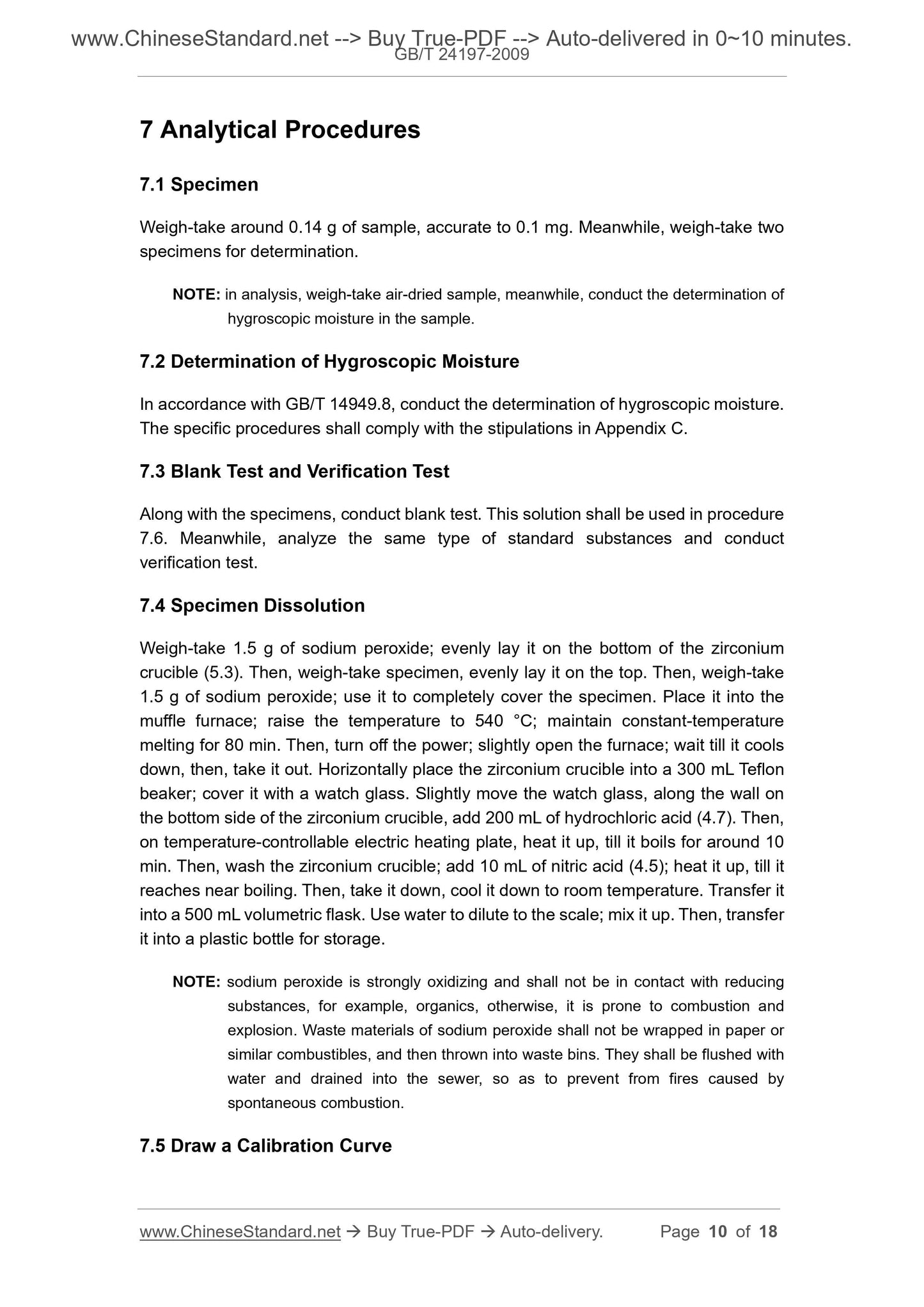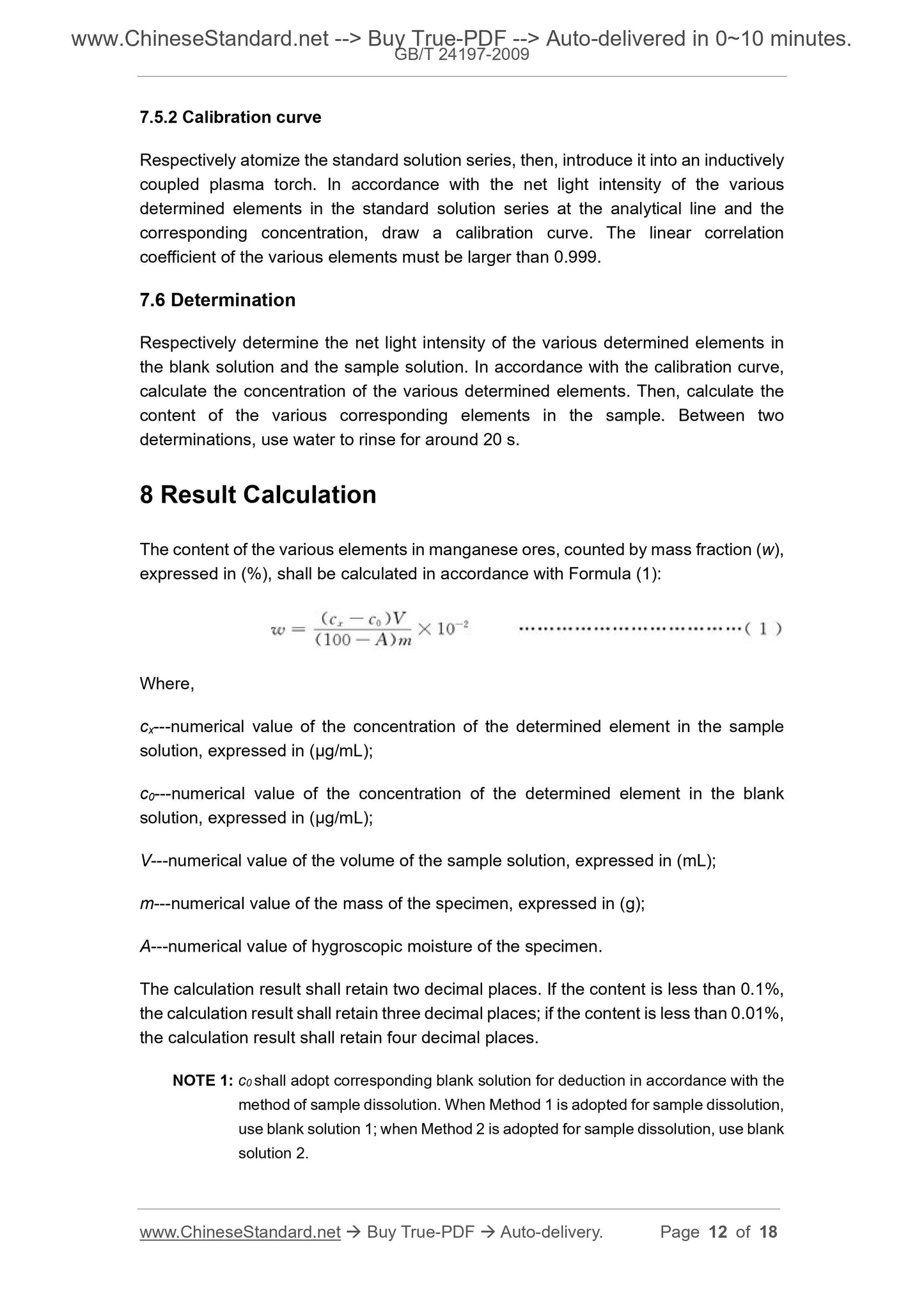1
/
of
7
www.ChineseStandard.us -- Field Test Asia Pte. Ltd.
GB/T 24197-2009 English PDF (GB/T24197-2009)
GB/T 24197-2009 English PDF (GB/T24197-2009)
Regular price
$150.00
Regular price
Sale price
$150.00
Unit price
/
per
Shipping calculated at checkout.
Couldn't load pickup availability
GB/T 24197-2009: Manganese Ores - Determination of Iron, Silicon, Aluminum, Calcium, Barium, Magnesium, Potassium, Copper, Nickel, Zinc, Phosphorus, Cobalt, Chromium, Vanadium, Arsenic, Lead, Titanium and Vanadium - Inductively Coupled Plasma Atomic Emission Spectrometry
Delivery: 9 seconds. Download (& Email) true-PDF + Invoice.
Get Quotation: Click GB/T 24197-2009 (Self-service in 1-minute)
Historical versions (Master-website): GB/T 24197-2009
Preview True-PDF (Reload/Scroll-down if blank)
GB/T 24197-2009
NATIONAL STANDARD OF THE
PEOPLE’S REPUBLIC OF CHINA
ICS 73.060.20
D 32
Manganese Ores - Determination of Iron, Silicon,
Aluminum, Calcium, Barium, Magnesium, Potassium,
Copper, Nickel, Zinc, Phosphorus, Cobalt, Chromium,
Vanadium, Arsenic, Lead, Titanium and Vanadium -
Inductively Coupled Plasma Atomic Emission
Spectrometry
ISSUED ON: JULY 8, 2009
IMPLEMENTED ON: APRIL 1, 2010
Issued by: General Administration of Quality Supervision, Inspection and
Quarantine;
Standardization Administration of the People’s Republic of
China.
Table of Contents
Foreword ... 3
1 Scope ... 4
2 Normative References ... 5
3 Principle ... 6
4 Reagents ... 6
5 Instrument and Equipment ... 9
6 Sample Preparation ... 9
7 Analytical Procedures ... 10
8 Result Calculation ... 12
9 Precision ... 13
10 Test Report ... 14
Appendix A (informative) Recommended Analytical Line and Range of
Application of Elements ... 16
Appendix B (informative) Reference Working Conditions of Instrument ... 17
Appendix C (normative) Determination of Hygroscopic Moisture ... 18
Manganese Ores - Determination of Iron, Silicon,
Aluminum, Calcium, Barium, Magnesium, Potassium,
Copper, Nickel, Zinc, Phosphorus, Cobalt, Chromium,
Vanadium, Arsenic, Lead, Titanium and Vanadium -
Inductively Coupled Plasma Atomic Emission
Spectrometry
Warning: personnel adopting this Standard shall have practical experience of
working in a regular laboratory. This Standard does not point out all the possible
safety issues. It is the responsibility of the user to take appropriate safety and
health measures and to guarantee the compliance with the conditions stipulated
by relevant national regulations.
1 Scope
This Standard stipulates the determination of iron, silicon, aluminum, calcium, barium,
magnesium, potassium, copper, nickel, zinc, phosphorous, cobalt, chromium,
vanadium, arsenic, lead and titanium in manganese ores through inductively coupled
plasma atomic emission spectrometry.
This Standard is applicable to the simultaneous determination of 17 elements (iron,
silicon, aluminum, calcium, barium, magnesium, potassium, copper, nickel, zinc,
phosphorous, cobalt, chromium, vanadium, arsenic, lead and titanium) in manganese
ores. It is also applicable to the determination of several elements among them. The
content range of the determined elements is shown in Table 1.
- Part 1: General Principles and Definitions (GB/T 6379.1-2004, ISO 5725-1:1994, IDT)
GB/T 6379.2 Accuracy (trueness and precision) of Measurement Methods and Results
- Part 2: Basic Method for the Determination of Repeatability and Reproducibility of a
Standard Measurement Method (GB/T 6379.2-2004, ISO 5725-2:1994, IDT)
GB/T 6682 Water for Analytical Laboratory Use - Specification and Test Methods (GB/T
6682-2008, ISO 3696:1987, MOD)
GB/T 14949.8 Manganese Ores - Determination of Hygroscopic Moisture Content in
Analytical Samples (GB/T 14949.8-1994, eqv ISO 310:1981)
3 Principle
Use sodium peroxide to melt the specimen in a zirconium crucible; use hydrochloric
acid to leach it; dilute it to a certain volume. Use a high-salt resistant atomizer and
corresponding fog chamber; atomize the sample solution, then, introduce it into an
inductively coupled plasma torch. Determine the net light intensity of the various
elements at the analytical line. In accordance with the established calibration curve,
calculate the concentration of the various elements in the sample solution. Then, in
accordance with the concentration, the mass of the specimen, and the volume of the
sample solution after deducting the hygroscopic moisture, calculate the content of the
various elements in the specimen.
4 Reagents
Unless it is otherwise stipulated, reagents that are confirmed to be analytically pure
shall merely be used in the analysis.
4.1 Water, Grade-2 water stipulated in GB/T 6682.
4.2 Sodium peroxide.
4.3 Anhydrous sodium carbonate, excellent grade of purity.
4.4 Hydrochloric acid, 1.19 g/mL, excellent grade of purity.
4.5 Nitric acid, 1.42 g/mL, excellent grade of purity.
4.6 Hydrochloric acid, 1 + 1.
4.7 Hydrochloric acid, 1 + 4.
4.8 Nitric acid, 1 + 9.
4.9 Manganese standard solution, 4.0 mg/mL.
mL volumetric flask. Use water to dilute to the scale; mix it up.
4.14 Barium standard solution, 0.8 mg/mL.
Weigh-take 1.5238 g of barium nitrate (spectrally pure; beforehand, at 105 °C, dry for
1 h; place it in a desiccator, then, cool it down to room temperature) in a 1,000 mL
beaker. Add around 100 mL of water and 100 mL of nitric acid (4.5); heat it up, dissolve
it, then, cool it down to room temperature. Transfer it into a 1,000 mL volumetric flask.
Use water to dilute to the scale; mix it up.
4.15 Magnesium and potassium mixed standard solution (magnesium: 0.4 mg/mL;
potassium: 0.4 mg/mL).
Weigh-take 0.6632 g of magnesium oxide (spectrally pure; beforehand, burn it at
1,000 °C for 1 h, then, place it in a desiccator, then, cool it down to room temperature)
and 0.7626 g of potassium chloride (spectrally pure; beforehand, at 105 °C, dry for 1
h; place it in a desiccator, then, cool it down to room temperature) in a 1,000 mL beaker.
Add 100 mL of nitric acid (4.5). After gentle heating and dissolution, cool it down to
room temperature. Transfer it into a 1,000 mL volumetric flask. Use water to dilute to
the scale; mix it up.
4.16 Single-element standard stock solution
Standard stock solutions of copper, nickel, zinc, phosphorus, cobalt, chromium,
vanadium, arsenic, lead and titanium shall be prepared in accordance with the
methods in GB/T 602, or, directly use single-element national standard solutions,
whose mass concentration shall be 1.0 mg/mL. Specifically speaking, the standard
stock solution of titanium may be sulfuric acid medium of the volume fraction of 10%;
the others shall adopt non-sulfuric acid medium.
4.17 Mixed standard solution of copper, nickel, zinc, phosphorus, cobalt, chromium,
vanadium, arsenic and lead; the mass concentration of each element shall be: 100
μg/mL.
Respectively transfer-take 10 mL of copper, nickel, zinc, phosphorus, cobalt, chromium,
vanadium, arsenic and lead single-element standard stock solution (4.16) in a 100 mL
volumetric flask. Use water to dilute to the scale; mix it up.
4.18 Titanium standard solution, 100 μg/mL.
Transfer-take 100 mL of titanium single-element standard stock solution (4.16) in a 100
mL volumetric flask. Use water to dilute to the scale; mix it up. Prepare it right before
usage.
4.19 Reagent blank stock solution.
Weigh-take 6.0 g of sodium peroxide in a 300 mL Teflon beaker. Add around 100 mL
7 Analytical Procedures
7.1 Specimen
Weigh-take around 0.14 g of sample, accurate to 0.1 mg. Meanwhile, weigh-take two
specimens for determination.
NOTE: in analysis, weigh-take air-dried sample, meanwhile, conduct the determination of
hygroscopic moisture in the sample.
7.2 Determination of Hygroscopic Moisture
In accordance with GB/T 14949.8, conduct the determination of hygroscopic moisture.
The specific procedures shall comply with the stipulations in Appendix C.
7.3 Blank Test and Verification Test
Along with the specimens, conduct blank test. This solution shall be used in procedure
7.6. Meanwhile, analyze the same type of standard substances and conduct
verification test.
7.4 Specimen Dissolution
Weigh-take 1.5 g of sodium peroxide; evenly lay it on the bottom of the zirconium
crucible (5.3). Then, weigh-take specimen, evenly lay it on the top. Then, weigh-take
1.5 g of sodium peroxide; use it to completely cover the specimen. Place it into the
muffle furnace; raise the temperature to 540 °C; maintain constant-temperature
melting for 80 min. Then, turn off the power; slightly open the furnace; wait till it cools
down, then, take it out. Horizontally place the zirconium crucible into a 300 mL Teflon
beaker; cover it with a watch glass. Slightly move the watch glass, along the wall on
the bottom side of the zirconium crucible, add 200 mL of hydrochloric acid (4.7). Then,
on temperature-controllable electric heating plate, heat it up, till it boils for around 10
min. Then, wash the zirconium crucible; add 10 mL of nitric acid (4.5); heat it up, till it
reaches near boiling. Then, take it down, cool it down to room temperature. Transfer it
into a 500 mL volumetric flask. Use water to dilute to the scale; mix it up. Then, transfer
it into a plastic bottle for storage.
NOTE: sodium peroxide is strongly oxidizing and shall not be in contact with reducing
substances, for example, organics, otherwise, it is prone to combustion and
explosion. Waste materials of sodium peroxide shall not be wrapped in paper or
similar combustibles, and then thrown into waste bins. They shall be flushed with
water and drained into the sewer, so as to prevent from fires caused by
spontaneous combustion.
7.5 Draw a Calibration Curve
7.5.2 Calibration curve
Respectively atomize the standard solution series, then, introduce it into an inductively
coupled plasma torch. In accordance with the net light intensity of the various
determined elements in the standard solution series at the analytical line and the
corresponding concentration, draw a calibration curve. The linear correlation
coefficient of the various elements must be larger than 0.999.
7.6 Determination
Respectively determine the net light intensity of the various determined elements in
the blank solution and the sample solution. In accordance with the calibration curve,
calculate the concentration of the various determined elements. Then, calculate the
content of the various corresponding elements in the sample. Between two
determinations, use water to rinse for around 20 s.
8 Result Calculation
The content of the various elements in manganese ores, counted by mass fraction (w),
expressed in (%), shall be calculated in accordance with Formula (1):
Where,
cx---numerical value of the concentration of the determined element in the sample
solution, expressed in (μg/mL);
c0---numerical value of the concentration of the determined element in the blank
solution, expressed in (μg/mL);
V---numerical value of the volume of the sample solution, expressed in (mL);
m---numerical value of the mass of the specimen, expressed in (g);
A---numerical value of hygroscopic moisture of the specimen.
The calculation result shall retain two decimal places. If the content is less than 0.1%,
the calculation result shall retain three decimal places; if the content is less than 0.01%,
the calculation result shall retain four decimal places.
NOTE 1: c0 shall adopt corresponding blank solution for deduction in accordance with the
method of sample dissolution. When Method 1 is adopted for sample dissolution,
use blank solution 1; when Method 2 is adopted for sample dissolution, use blank
solution 2.
GB/T 24197-2009
NATIONAL STANDARD OF THE
PEOPLE’S REPUBLIC OF CHINA
ICS 73.060.20
D 32
Manganese Ores - Determination of Iron, Silicon,
Aluminum, Calcium, Barium, Magnesium, Potassium,
Copper, Nickel, Zinc, Phosphorus, Cobalt, Chromium,
Vanadium, Arsenic, Lead, Titanium and Vanadium -
Inductively Coupled Plasma Atomic Emission
Spectrometry
ISSUED ON: JULY 8, 2009
IMPLEMENTED ON: APRIL 1, 2010
Issued by: General Administration of Quality Supervision, Inspection and
Quarantine;
Standardization Administration of the People’s Republic of
China.
Table of Contents
Foreword ... 3
1 Scope ... 4
2 Normative References ... 5
3 Principle ... 6
4 Reagents ... 6
5 Instrument and Equipment ... 9
6 Sample Preparation ... 9
7 Analytical Procedures ... 10
8 Result Calculation ... 12
9 Precision ... 13
10 Test Report ... 14
Appendix A (informative) Recommended Analytical Line and Range of
Application of Elements ... 16
Appendix B (informative) Reference Working Conditions of Instrument ... 17
Appendix C (normative) Determination of Hygroscopic Moisture ... 18
Manganese Ores - Determination of Iron, Silicon,
Aluminum, Calcium, Barium, Magnesium, Potassium,
Copper, Nickel, Zinc, Phosphorus, Cobalt, Chromium,
Vanadium, Arsenic, Lead, Titanium and Vanadium -
Inductively Coupled Plasma Atomic Emission
Spectrometry
Warning: personnel adopting this Standard shall have practical experience of
working in a regular laboratory. This Standard does not point out all the possible
safety issues. It is the responsibility of the user to take appropriate safety and
health measures and to guarantee the compliance with the conditions stipulated
by relevant national regulations.
1 Scope
This Standard stipulates the determination of iron, silicon, aluminum, calcium, barium,
magnesium, potassium, copper, nickel, zinc, phosphorous, cobalt, chromium,
vanadium, arsenic, lead and titanium in manganese ores through inductively coupled
plasma atomic emission spectrometry.
This Standard is applicable to the simultaneous determination of 17 elements (iron,
silicon, aluminum, calcium, barium, magnesium, potassium, copper, nickel, zinc,
phosphorous, cobalt, chromium, vanadium, arsenic, lead and titanium) in manganese
ores. It is also applicable to the determination of several elements among them. The
content range of the determined elements is shown in Table 1.
- Part 1: General Principles and Definitions (GB/T 6379.1-2004, ISO 5725-1:1994, IDT)
GB/T 6379.2 Accuracy (trueness and precision) of Measurement Methods and Results
- Part 2: Basic Method for the Determination of Repeatability and Reproducibility of a
Standard Measurement Method (GB/T 6379.2-2004, ISO 5725-2:1994, IDT)
GB/T 6682 Water for Analytical Laboratory Use - Specification and Test Methods (GB/T
6682-2008, ISO 3696:1987, MOD)
GB/T 14949.8 Manganese Ores - Determination of Hygroscopic Moisture Content in
Analytical Samples (GB/T 14949.8-1994, eqv ISO 310:1981)
3 Principle
Use sodium peroxide to melt the specimen in a zirconium...
Delivery: 9 seconds. Download (& Email) true-PDF + Invoice.
Get Quotation: Click GB/T 24197-2009 (Self-service in 1-minute)
Historical versions (Master-website): GB/T 24197-2009
Preview True-PDF (Reload/Scroll-down if blank)
GB/T 24197-2009
NATIONAL STANDARD OF THE
PEOPLE’S REPUBLIC OF CHINA
ICS 73.060.20
D 32
Manganese Ores - Determination of Iron, Silicon,
Aluminum, Calcium, Barium, Magnesium, Potassium,
Copper, Nickel, Zinc, Phosphorus, Cobalt, Chromium,
Vanadium, Arsenic, Lead, Titanium and Vanadium -
Inductively Coupled Plasma Atomic Emission
Spectrometry
ISSUED ON: JULY 8, 2009
IMPLEMENTED ON: APRIL 1, 2010
Issued by: General Administration of Quality Supervision, Inspection and
Quarantine;
Standardization Administration of the People’s Republic of
China.
Table of Contents
Foreword ... 3
1 Scope ... 4
2 Normative References ... 5
3 Principle ... 6
4 Reagents ... 6
5 Instrument and Equipment ... 9
6 Sample Preparation ... 9
7 Analytical Procedures ... 10
8 Result Calculation ... 12
9 Precision ... 13
10 Test Report ... 14
Appendix A (informative) Recommended Analytical Line and Range of
Application of Elements ... 16
Appendix B (informative) Reference Working Conditions of Instrument ... 17
Appendix C (normative) Determination of Hygroscopic Moisture ... 18
Manganese Ores - Determination of Iron, Silicon,
Aluminum, Calcium, Barium, Magnesium, Potassium,
Copper, Nickel, Zinc, Phosphorus, Cobalt, Chromium,
Vanadium, Arsenic, Lead, Titanium and Vanadium -
Inductively Coupled Plasma Atomic Emission
Spectrometry
Warning: personnel adopting this Standard shall have practical experience of
working in a regular laboratory. This Standard does not point out all the possible
safety issues. It is the responsibility of the user to take appropriate safety and
health measures and to guarantee the compliance with the conditions stipulated
by relevant national regulations.
1 Scope
This Standard stipulates the determination of iron, silicon, aluminum, calcium, barium,
magnesium, potassium, copper, nickel, zinc, phosphorous, cobalt, chromium,
vanadium, arsenic, lead and titanium in manganese ores through inductively coupled
plasma atomic emission spectrometry.
This Standard is applicable to the simultaneous determination of 17 elements (iron,
silicon, aluminum, calcium, barium, magnesium, potassium, copper, nickel, zinc,
phosphorous, cobalt, chromium, vanadium, arsenic, lead and titanium) in manganese
ores. It is also applicable to the determination of several elements among them. The
content range of the determined elements is shown in Table 1.
- Part 1: General Principles and Definitions (GB/T 6379.1-2004, ISO 5725-1:1994, IDT)
GB/T 6379.2 Accuracy (trueness and precision) of Measurement Methods and Results
- Part 2: Basic Method for the Determination of Repeatability and Reproducibility of a
Standard Measurement Method (GB/T 6379.2-2004, ISO 5725-2:1994, IDT)
GB/T 6682 Water for Analytical Laboratory Use - Specification and Test Methods (GB/T
6682-2008, ISO 3696:1987, MOD)
GB/T 14949.8 Manganese Ores - Determination of Hygroscopic Moisture Content in
Analytical Samples (GB/T 14949.8-1994, eqv ISO 310:1981)
3 Principle
Use sodium peroxide to melt the specimen in a zirconium crucible; use hydrochloric
acid to leach it; dilute it to a certain volume. Use a high-salt resistant atomizer and
corresponding fog chamber; atomize the sample solution, then, introduce it into an
inductively coupled plasma torch. Determine the net light intensity of the various
elements at the analytical line. In accordance with the established calibration curve,
calculate the concentration of the various elements in the sample solution. Then, in
accordance with the concentration, the mass of the specimen, and the volume of the
sample solution after deducting the hygroscopic moisture, calculate the content of the
various elements in the specimen.
4 Reagents
Unless it is otherwise stipulated, reagents that are confirmed to be analytically pure
shall merely be used in the analysis.
4.1 Water, Grade-2 water stipulated in GB/T 6682.
4.2 Sodium peroxide.
4.3 Anhydrous sodium carbonate, excellent grade of purity.
4.4 Hydrochloric acid, 1.19 g/mL, excellent grade of purity.
4.5 Nitric acid, 1.42 g/mL, excellent grade of purity.
4.6 Hydrochloric acid, 1 + 1.
4.7 Hydrochloric acid, 1 + 4.
4.8 Nitric acid, 1 + 9.
4.9 Manganese standard solution, 4.0 mg/mL.
mL volumetric flask. Use water to dilute to the scale; mix it up.
4.14 Barium standard solution, 0.8 mg/mL.
Weigh-take 1.5238 g of barium nitrate (spectrally pure; beforehand, at 105 °C, dry for
1 h; place it in a desiccator, then, cool it down to room temperature) in a 1,000 mL
beaker. Add around 100 mL of water and 100 mL of nitric acid (4.5); heat it up, dissolve
it, then, cool it down to room temperature. Transfer it into a 1,000 mL volumetric flask.
Use water to dilute to the scale; mix it up.
4.15 Magnesium and potassium mixed standard solution (magnesium: 0.4 mg/mL;
potassium: 0.4 mg/mL).
Weigh-take 0.6632 g of magnesium oxide (spectrally pure; beforehand, burn it at
1,000 °C for 1 h, then, place it in a desiccator, then, cool it down to room temperature)
and 0.7626 g of potassium chloride (spectrally pure; beforehand, at 105 °C, dry for 1
h; place it in a desiccator, then, cool it down to room temperature) in a 1,000 mL beaker.
Add 100 mL of nitric acid (4.5). After gentle heating and dissolution, cool it down to
room temperature. Transfer it into a 1,000 mL volumetric flask. Use water to dilute to
the scale; mix it up.
4.16 Single-element standard stock solution
Standard stock solutions of copper, nickel, zinc, phosphorus, cobalt, chromium,
vanadium, arsenic, lead and titanium shall be prepared in accordance with the
methods in GB/T 602, or, directly use single-element national standard solutions,
whose mass concentration shall be 1.0 mg/mL. Specifically speaking, the standard
stock solution of titanium may be sulfuric acid medium of the volume fraction of 10%;
the others shall adopt non-sulfuric acid medium.
4.17 Mixed standard solution of copper, nickel, zinc, phosphorus, cobalt, chromium,
vanadium, arsenic and lead; the mass concentration of each element shall be: 100
μg/mL.
Respectively transfer-take 10 mL of copper, nickel, zinc, phosphorus, cobalt, chromium,
vanadium, arsenic and lead single-element standard stock solution (4.16) in a 100 mL
volumetric flask. Use water to dilute to the scale; mix it up.
4.18 Titanium standard solution, 100 μg/mL.
Transfer-take 100 mL of titanium single-element standard stock solution (4.16) in a 100
mL volumetric flask. Use water to dilute to the scale; mix it up. Prepare it right before
usage.
4.19 Reagent blank stock solution.
Weigh-take 6.0 g of sodium peroxide in a 300 mL Teflon beaker. Add around 100 mL
7 Analytical Procedures
7.1 Specimen
Weigh-take around 0.14 g of sample, accurate to 0.1 mg. Meanwhile, weigh-take two
specimens for determination.
NOTE: in analysis, weigh-take air-dried sample, meanwhile, conduct the determination of
hygroscopic moisture in the sample.
7.2 Determination of Hygroscopic Moisture
In accordance with GB/T 14949.8, conduct the determination of hygroscopic moisture.
The specific procedures shall comply with the stipulations in Appendix C.
7.3 Blank Test and Verification Test
Along with the specimens, conduct blank test. This solution shall be used in procedure
7.6. Meanwhile, analyze the same type of standard substances and conduct
verification test.
7.4 Specimen Dissolution
Weigh-take 1.5 g of sodium peroxide; evenly lay it on the bottom of the zirconium
crucible (5.3). Then, weigh-take specimen, evenly lay it on the top. Then, weigh-take
1.5 g of sodium peroxide; use it to completely cover the specimen. Place it into the
muffle furnace; raise the temperature to 540 °C; maintain constant-temperature
melting for 80 min. Then, turn off the power; slightly open the furnace; wait till it cools
down, then, take it out. Horizontally place the zirconium crucible into a 300 mL Teflon
beaker; cover it with a watch glass. Slightly move the watch glass, along the wall on
the bottom side of the zirconium crucible, add 200 mL of hydrochloric acid (4.7). Then,
on temperature-controllable electric heating plate, heat it up, till it boils for around 10
min. Then, wash the zirconium crucible; add 10 mL of nitric acid (4.5); heat it up, till it
reaches near boiling. Then, take it down, cool it down to room temperature. Transfer it
into a 500 mL volumetric flask. Use water to dilute to the scale; mix it up. Then, transfer
it into a plastic bottle for storage.
NOTE: sodium peroxide is strongly oxidizing and shall not be in contact with reducing
substances, for example, organics, otherwise, it is prone to combustion and
explosion. Waste materials of sodium peroxide shall not be wrapped in paper or
similar combustibles, and then thrown into waste bins. They shall be flushed with
water and drained into the sewer, so as to prevent from fires caused by
spontaneous combustion.
7.5 Draw a Calibration Curve
7.5.2 Calibration curve
Respectively atomize the standard solution series, then, introduce it into an inductively
coupled plasma torch. In accordance with the net light intensity of the various
determined elements in the standard solution series at the analytical line and the
corresponding concentration, draw a calibration curve. The linear correlation
coefficient of the various elements must be larger than 0.999.
7.6 Determination
Respectively determine the net light intensity of the various determined elements in
the blank solution and the sample solution. In accordance with the calibration curve,
calculate the concentration of the various determined elements. Then, calculate the
content of the various corresponding elements in the sample. Between two
determinations, use water to rinse for around 20 s.
8 Result Calculation
The content of the various elements in manganese ores, counted by mass fraction (w),
expressed in (%), shall be calculated in accordance with Formula (1):
Where,
cx---numerical value of the concentration of the determined element in the sample
solution, expressed in (μg/mL);
c0---numerical value of the concentration of the determined element in the blank
solution, expressed in (μg/mL);
V---numerical value of the volume of the sample solution, expressed in (mL);
m---numerical value of the mass of the specimen, expressed in (g);
A---numerical value of hygroscopic moisture of the specimen.
The calculation result shall retain two decimal places. If the content is less than 0.1%,
the calculation result shall retain three decimal places; if the content is less than 0.01%,
the calculation result shall retain four decimal places.
NOTE 1: c0 shall adopt corresponding blank solution for deduction in accordance with the
method of sample dissolution. When Method 1 is adopted for sample dissolution,
use blank solution 1; when Method 2 is adopted for sample dissolution, use blank
solution 2.
GB/T 24197-2009
NATIONAL STANDARD OF THE
PEOPLE’S REPUBLIC OF CHINA
ICS 73.060.20
D 32
Manganese Ores - Determination of Iron, Silicon,
Aluminum, Calcium, Barium, Magnesium, Potassium,
Copper, Nickel, Zinc, Phosphorus, Cobalt, Chromium,
Vanadium, Arsenic, Lead, Titanium and Vanadium -
Inductively Coupled Plasma Atomic Emission
Spectrometry
ISSUED ON: JULY 8, 2009
IMPLEMENTED ON: APRIL 1, 2010
Issued by: General Administration of Quality Supervision, Inspection and
Quarantine;
Standardization Administration of the People’s Republic of
China.
Table of Contents
Foreword ... 3
1 Scope ... 4
2 Normative References ... 5
3 Principle ... 6
4 Reagents ... 6
5 Instrument and Equipment ... 9
6 Sample Preparation ... 9
7 Analytical Procedures ... 10
8 Result Calculation ... 12
9 Precision ... 13
10 Test Report ... 14
Appendix A (informative) Recommended Analytical Line and Range of
Application of Elements ... 16
Appendix B (informative) Reference Working Conditions of Instrument ... 17
Appendix C (normative) Determination of Hygroscopic Moisture ... 18
Manganese Ores - Determination of Iron, Silicon,
Aluminum, Calcium, Barium, Magnesium, Potassium,
Copper, Nickel, Zinc, Phosphorus, Cobalt, Chromium,
Vanadium, Arsenic, Lead, Titanium and Vanadium -
Inductively Coupled Plasma Atomic Emission
Spectrometry
Warning: personnel adopting this Standard shall have practical experience of
working in a regular laboratory. This Standard does not point out all the possible
safety issues. It is the responsibility of the user to take appropriate safety and
health measures and to guarantee the compliance with the conditions stipulated
by relevant national regulations.
1 Scope
This Standard stipulates the determination of iron, silicon, aluminum, calcium, barium,
magnesium, potassium, copper, nickel, zinc, phosphorous, cobalt, chromium,
vanadium, arsenic, lead and titanium in manganese ores through inductively coupled
plasma atomic emission spectrometry.
This Standard is applicable to the simultaneous determination of 17 elements (iron,
silicon, aluminum, calcium, barium, magnesium, potassium, copper, nickel, zinc,
phosphorous, cobalt, chromium, vanadium, arsenic, lead and titanium) in manganese
ores. It is also applicable to the determination of several elements among them. The
content range of the determined elements is shown in Table 1.
- Part 1: General Principles and Definitions (GB/T 6379.1-2004, ISO 5725-1:1994, IDT)
GB/T 6379.2 Accuracy (trueness and precision) of Measurement Methods and Results
- Part 2: Basic Method for the Determination of Repeatability and Reproducibility of a
Standard Measurement Method (GB/T 6379.2-2004, ISO 5725-2:1994, IDT)
GB/T 6682 Water for Analytical Laboratory Use - Specification and Test Methods (GB/T
6682-2008, ISO 3696:1987, MOD)
GB/T 14949.8 Manganese Ores - Determination of Hygroscopic Moisture Content in
Analytical Samples (GB/T 14949.8-1994, eqv ISO 310:1981)
3 Principle
Use sodium peroxide to melt the specimen in a zirconium...
Share
